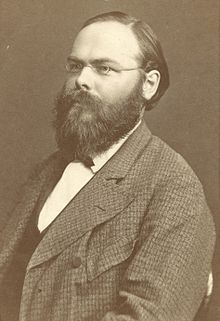Hermann Schwarz
Hermann Schwarz | |
|---|---|
 Karl Hermann Amandus Schwarz | |
| Born | 25 January 1843 |
| Died | 30 November 1921 (aged 78) |
| Nationality | Prussian |
| Alma mater | Gewerbeinstitut |
| Known for | Cauchy–Schwarz inequality |
| Scientific career | |
| Fields | Mathematician |
| Institutions | University of Halle Swiss Federal Polytechnic Göttingen University |
| Doctoral advisor | Karl Weierstrass Ernst Kummer |
| Doctoral students | Lipót Fejér Harris Hancock Gerhard Hessenberg Paul Koebe Leon Lichtenstein Heinrich Maschke Robert Remak Theodor Vahlen Ernst Zermelo |
Karl Hermann Amandus Schwarz (German: [ˈhɛʁman ˈʃvaʁts]; 25 January 1843 – 30 November 1921) was a German mathematician, known for his work in complex analysis.
Life
Schwarz was born in Hermsdorf, Silesia (now Jerzmanowa, Poland). On 30 June 1912 he married Marie Kummer, who was the daughter to the mathematician Ernst Eduard Kummer[1] and Ottilie née Mendelssohn (a daughter of Nathan Mendelssohn's and granddaughter of Moses Mendelssohn). Schwarz and Kummer had six children, including his daughter Emily Schwarz.[1]
Schwarz originally studied chemistry in Berlin but Ernst Eduard Kummer and Karl Theodor Wilhelm Weierstrass persuaded him to change to mathematics.[2] He received his Ph.D. from the Universität Berlin in 1864 and was advised by Ernst Kummer and Karl Weierstraß.[3] Between 1867 and 1869 he worked at the University of Halle, then at the Swiss Federal Polytechnic.[4] From 1875 he worked at Göttingen University,[4] dealing with the subjects of complex analysis, differential geometry and the calculus of variations. He died in Berlin.
Work
Schwarz's works include Bestimmung einer speziellen Minimalfläche, which was crowned by the Berlin Academy in 1867 and printed in 1871, and Gesammelte mathematische Abhandlungen (1890).
Among other things, Schwarz improved the proof of the Riemann mapping theorem,[5] developed a special case of the Cauchy–Schwarz inequality, and gave a proof that the ball has less surface area than any other body of equal volume.[6] His work on the latter allowed Émile Picard to show solutions of differential equations exist (the Picard–Lindelöf theorem).[2]
In 1892 he became a member of the Berlin Academy of Science and a professor at the University of Berlin, where his students included Lipót Fejér, Paul Koebe and Ernst Zermelo. In total, he advised 20 Ph.D students.[3]
His name is attached to many ideas in mathematics,[1] including the following:
- Additive Schwarz method
- Schwarz alternating method
- Schwarzian derivative
- Schwarz function
- Schwarz lantern
- Schwarz lemma
- Schwarz's list
- Schwarz minimal surface
- Schwarz theorem (also known as Clairaut's theorem)
- Schwarz integral formula
- Schwarz–Christoffel mapping
- Schwarz–Ahlfors–Pick theorem
- Schwarz reflection principle
- Schwarz triangle
- Schwarz triangle map
- Cauchy–Schwarz inequality.
Publications
- Schwarz, H. A. (1871), Bestimmung einer speziellen Minimalfläche, Dümmler
- Schwarz, H. A. (1972) [1890], Gesammelte mathematische Abhandlungen. Band I, II, Bronx, N.Y.: AMS Chelsea Publishing, ISBN 978-0-8284-0260-6, MR 0392470
Notes
- ^ a b c Agarwal, Ravi; Sen, Syamal (2014-11-11). Creators of Mathematical and Computational Sciences. Springer. pp. 297–298. ISBN 9783319108704.
- ^ a b O'Connor, J. J.; Robertson, E. F. "Schwarz biography". www-gap.dcs.st-and.ac.uk. The MacTutor History of Mathematics. Archived from the original on 2016-06-05. Retrieved 2016-05-22.
- ^ a b "The Mathematics Genealogy Project - Hermann Schwarz". www.genealogy.math.ndsu.nodak.edu. Retrieved 2016-05-22.
- ^ a b Chang, Sooyoung (2011-01-01). Academic Genealogy of Mathematicians. World Scientific. pp. 77–78. ISBN 9789814282291.
- ^ Bottazzini, Umberto (2003-04-30). "Algebraic truths vs geometric fantasies: Weierstrass' Response to Riemann". arXiv:math/0305022.
- ^ Schwarz, Hermann Amandus (1884). "Proof of the theorem that the ball has less surface area than any other body of the same volume". News of the Royal Society of Sciences and the Georg-August-Universität Göttingen. 1884: 1–13.
External links
- 1843 births
- 1921 deaths
- 20th-century German mathematicians
- 19th-century German mathematicians
- ETH Zurich faculty
- University of Göttingen faculty
- Martin Luther University of Halle-Wittenberg faculty
- Humboldt University of Berlin faculty
- Corresponding Members of the St Petersburg Academy of Sciences
- People from the Province of Silesia
- People from Głogów County
